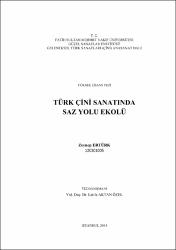| dc.contributor.advisor | Aktan Özel, Latife | |
| dc.contributor.author | Ertürk, Zeynep | |
| dc.date.accessioned | 2014-11-10T12:07:12Z | |
| dc.date.available | 2014-11-10T12:07:12Z | |
| dc.date.issued | 2014 | |
| dc.identifier.citation | ERTÜRK, Zeynep, Türk Çini Sanatında Saz Yolu Ekolü, Fatih Sultan Mehmet Vakıf Üniversitesi Güzel Sanatlar Enstitüsü Geleneksel Türk Sanatları (Çini) Anasanat Dalı, Yayımlanmamış Yüksek Lisans Tezi, İstanbul 2014 | en_US |
| dc.identifier.uri | https://hdl.handle.net/11352/2115 | |
| dc.description.abstract | Kanûnî Sultan Süleyman dönemi Osmanlı Saray nakkaşhânesi sernakkaşı olan Şah Kulu, “Saz Yolu” adıyla bilinen bezeme üslûbunun ilk temsilcisidir.
XVI. yüzyıl ilk yarısından XVII. yüzyıl başlarına kadar üretilmiş resimlerde, sivri uçlu kıvrık hançerî yapraklar, hatâyî üslûbu çiçekler, efsanevî hayvanlar (ejderha, zümrüd-ü ankā, ch’i-lin), orman hayvanları ve periler görülmektedir.
Kanûnî Sultan Süleyman devrinde en parlak dönemi yaşayan Osmanlı sanatında ortaya çıkmış olan bu üslûp padişah tarafından büyük beğeni kazanmış yüzyıllar içinde tezhip, halkâr, cilt, çini ve seramik sanatlarında, kalem işlerinde, kumaş, halı ve maden gibi sanatlarda en güzel örneklerini vermiştir.
XVI. yüzyılın ikinci yarısında Mimar Sinan’ın bazı yapılarında çiniyi bir tezyîni eleman olarak kullanması, bu yeni üslûbun çinide de en güzel örneklerinin ortaya çıkmasını sağlamıştır. Saray nakkaşhânesinin hazırlamış olduğu bezemeler İznik atölyelerinde çiniye sıraltı tekniği ile uygulanmıştır. Bu dönemde çinide teknik açıdan ulaşılan kalite, motif ve desenlerle birleşmiş ve mükemmel eserler ortaya çıkmıştır.
Şah Kulu tarafından Osmanlı süsleme sanatına katılmış olan saz üslûbunun çini sanatında da örnekleri görülmektedir.
“Türk Çini Sanatında Saz Yolu Ekolü” adlı tezimizde, bu üslûpta kullanılmış karakteristik motiflerin çini sanatında daha önce değerlendirilmemiş olması, çalışmanın önemini arttırmaktadır. Tez üç bölümden oluşmaktadır: Birinci bölümde Şah Kulu’nun hayatı, saz üslûbu ve bu üslûbun kullanıldığı diğer sanat dalları incelenmiştir. İkinci bölümde Topkapı Sarayı Sünnet Odası dış cephesindeki yekpâre saz üslubu pano’nun motif özellikleriyle beraber tanıtılmasına çalışılmış, üçüncü bölümde ise, İstanbul’daki bazı çinili yapılarda, Saz Yolu Ekolü’nün üslûp özelliklerini gösteren örneklerden yola çıkılarak, resimleri ile ayrıntılı olarak ele alınmıştır.
Değerlendirme ve Sonuç bölümde, saz üslûbu özellikleri taşıyan İstanbul’daki çinili yapılara ait örneklerin birbirleriyle benzerliklerini ve farklılıklarını ortaya koyan karşılaştırmalar, motif çizimleriyle bir arada verilmiştir.
Türk Çini sanatında saz üslûbu motiflerinin yeri ve öneminin çizimlerle ele alındığı bu tezin, bundan sonraki çalışmalara yardımcı olacağı düşüncesindeyiz. | en_US |
| dc.description.abstract | Şah Kulu who was the chief muralist of The Ottoman Palace Design-House (Nakkaşhâne) during the period of Suleiman The Magnificent is the first representative of Saz üslûbu (Leafy Way) decoration style. We can see the sharp-pointed, curved dagger-shaped leaves, (hatâyî) style flowers, mythical animals (dragon, phoenix, ch’i-lin), forest animals and fairies on the paintings made during from the first half of XVI. to the early XVII. centuries.
This style had its brightest era during the period of Suleiman The Magnificent who has shown a strong appreciation to its outcomes. And this style had produced its best samples in the arts of ornamentation, (halkâr), gold, book-binding, hand-drawn painting (kalem işi), clothes, carpet arts, mine working, tiling and ceramics for the centuries to come.
In the second half of XVI. century; by use of tiles on many of the structures, Royal Achitect (Mimar) Sinan had provided the best samples of this new style in tile art. Tiles designed by artists of Nakkaşhane were produced at Iznik (Nikeae) workhouses by applying the underglaze (sıraltı) technique. In this period; with a combintion of designs, figures and the technique, many tiles and kitchenware (evani) were produced with excellent quality. Moreover, in the same period, many good examples of saz-yolu style ornamentation by Şah Kulu were created.
In the present thesis, as its name “Saz-Yolu Ecole In Turkish Tile Art” (Türk Çini Sanatında Saz Yolu Ekolü) implies, an evaluation of the characteristic motifs used in this style attaching a special importance to it in the develoment of Turkih tile art. Present volume is composed of the following chapters: Şah Kulu’s life, the “saz-style” and many branches of art that uses this style are summarized in the first chapter. In the second chapter; the motif characteristic and description of the massive “Saz-Yolu” Pane on the external wall of the “Sünnet Odası” (The Circumcision Room) in Topkapı Palace has taken place.
In the third chapter; the samples that show the style characteristics of Saz üslûbuEcole on some tiled structures in İstanbul have been specified together with further information about these structures. Characteristics of specified motifs have also been represented in detail with their pictures.
In the assessment and conclusion chapter; the comparisons that represent the similarities and differences of the samples we have determined in Istanbul on the tiled structures showing the characteristics of saz style have been given with the motif drawings.
We have the opinion that our present perspective and approach with the detailed drawings, on the The Saz Style motifs in Turkish Tile Art will help the further studies in the area. | en_US |
| dc.language.iso | eng | en_US |
| dc.publisher | FSM Vakıf Üniversitesi | en_US |
| dc.rights | info:eu-repo/semantics/openAccess | en_US |
| dc.title | Türk Çini Sanatında Saz Yolu Ekolü | en_US |
| dc.type | masterThesis | en_US |
| dc.relation.publicationcategory | Tez | en_US |
| dc.contributor.institutionauthor | Ertürk, Zeynep | |



















